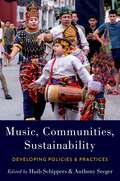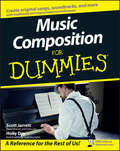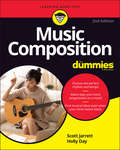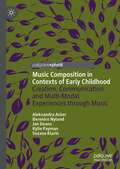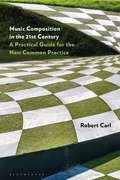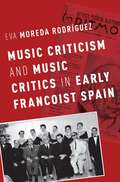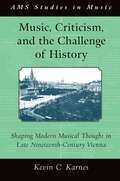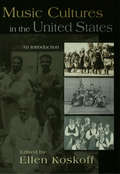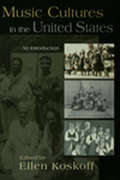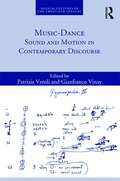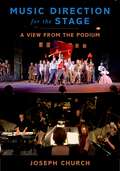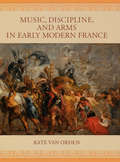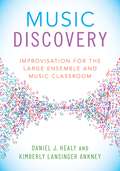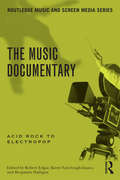- Table View
- List View
Music, Communities, Sustainability: Developing Policies and Practices
by Huib Schippers and Anthony SeegerMusic, Communities, Sustainability, edited thoughtfully by Huib Schippers and Anthony Seeger, traces the genesis, implementation, and development of the influential 2003 UNESCO Convention on Safeguarding of the Intangible Cultural Heritage and its impact on music practices around the world. With insights from established and emerging scholars who have been there from the early beginnings to those who work with it in communities today, this book tells a riveting story that celebrates the rise in awareness that approaching music as Intangible Cultural Heritage has brought. At the same time, it critiques the discrepancies between ideologies and realities as they emerged across the globe in its first twenty years, and provides perspectives for sound futures for the planet. Gathering such varied perspectives, this essential volume tells a crucial history and expands our understanding of the possibilities and limitations of interventions in music sustainability on a global scale.
Music, Communities, Sustainability: Developing Policies and Practices
Music, Communities, Sustainability, edited thoughtfully by Huib Schippers and Anthony Seeger, traces the genesis, implementation, and development of the influential 2003 UNESCO Convention on Safeguarding of the Intangible Cultural Heritage and its impact on music practices around the world. With insights from established and emerging scholars who have been there from the early beginnings to those who work with it in communities today, this book tells a riveting story that celebrates the rise in awareness that approaching music as Intangible Cultural Heritage has brought. At the same time, it critiques the discrepancies between ideologies and realities as they emerged across the globe in its first twenty years, and provides perspectives for sound futures for the planet. Gathering such varied perspectives, this essential volume tells a crucial history and expands our understanding of the possibilities and limitations of interventions in music sustainability on a global scale.
Music Composition For Dummies
by Scott Jarrett Holly DayWant to turn that haunting tune in your head into an awesome sound in your ear? You can! Music Composition For Dummies demystifies the process of composing music and writing songs. It guides you through every step of writing your own music, from choosing the right rhythm and tempo to creating melodies and chord progressions and working with instruments and voices. In this fun and practical guide, you’ll learn how to match keys and chords to the mood you want to convey, work a form without limiting your creativity, and hammer out a musical idea, even when your mind is drawing a blank. You’ll find out how to create popular songs, classically structured pieces, and even film, TV, and video game soundtracks. And, you’ll learn what you need to know about music composition software, including Finale, Sebelius, Pro Tools, and more. Discover how to: Preserve and organize your musical ideas Work with established chord progressions or create your own Develop great rhythms Select the right instruments Find melodies in your head, your instrument, and the world around you Use major and minor scales Work with modes and moods Build melodic motifs and phrases Use the circle of fifths to harmonize Write for multiple voices Make a demo recording Filled with creative exercises to build your composing skills, Music Composition for Dummies is the resource you need to get that melody out of your head and into the world.
Music Composition For Dummies
by Scott Jarrett Holly DayYou can hum it, but can you write it down? When most people think of a composer, they picture a bewigged genius like Mozart or Beethoven frenetically directing mighty orchestras in the ornate palaces of Vienna. While that may have been the case once upon a time, modern composers make themselves heard far beyond the classical conservatoire and concert hall. These days, soundtracks are in high demand in industries such as TV, film, advertising, and even gaming to help create immersive and exciting experiences. Whatever your musical ambitions—composing a dark requiem in a beautiful Viennese apartment or producing the next great Star Wars-like movie theme in LA—the fully updated Music Composition For Dummies hits all the right notes to help you become confident in the theory and practice of composition. To help you translate your musical ideas from fleeting tunes in your head to playable bars and notation on paper, professional composer and instructor Scott Jarrett and music journalist Holly Day take you on a friendly step-by-step journey through the process of musical creation, including choosing the right rhythms and tempos, creating melodies and chord progressions, and working with instruments and voices. You’ll learn how to match keys and chords to mood, use form to enhance your creativity, and write in different styles from pop to classical—and you’ll even learn how to keep hammering away when inspiration eludes you. Organize and preserve your musical ideas Formalize your knowledge with professional vocabulary Get familiar with composition apps and software Make a demo and market on social media Filled with musical exercises to help you acquire the discipline you need for success, Music Composition For Dummies has everything you need to turn your inner soundtrack into a tuneful reality!
Music Composition For Dummies
by Scott Jarrett Holly DayYou can hum it, but can you write it down? When most people think of a composer, they picture a bewigged genius like Mozart or Beethoven frenetically directing mighty orchestras in the ornate palaces of Vienna. While that may have been the case once upon a time, modern composers make themselves heard far beyond the classical conservatoire and concert hall. These days, soundtracks are in high demand in industries such as TV, film, advertising, and even gaming to help create immersive and exciting experiences. Whatever your musical ambitions—composing a dark requiem in a beautiful Viennese apartment or producing the next great Star Wars-like movie theme in LA—the fully updated Music Composition For Dummies hits all the right notes to help you become confident in the theory and practice of composition. To help you translate your musical ideas from fleeting tunes in your head to playable bars and notation on paper, professional composer and instructor Scott Jarrett and music journalist Holly Day take you on a friendly step-by-step journey through the process of musical creation, including choosing the right rhythms and tempos, creating melodies and chord progressions, and working with instruments and voices. You’ll learn how to match keys and chords to mood, use form to enhance your creativity, and write in different styles from pop to classical—and you’ll even learn how to keep hammering away when inspiration eludes you. Organize and preserve your musical ideas Formalize your knowledge with professional vocabulary Get familiar with composition apps and software Make a demo and market on social media Filled with musical exercises to help you acquire the discipline you need for success, Music Composition For Dummies has everything you need to turn your inner soundtrack into a tuneful reality!
Music Composition in Contexts of Early Childhood: Creation, Communication and Multi-Modal Experiences through Music
by Jan Deans Berenice Nyland Aleksandra Acker Kylie Payman Suzana KlarinThis book explores the narratives of a group of four-year-old children in a composition project in an Australian early learning centre. The participants, centre staff and a composer, Stephen Leek, contributed a number of music sessions for the children, including five original songs. The book showcases young children’s communicative ability and sensitivity to wider issues. The staff in the centre have a strongly voiced philosophy that is enacted through arts-based pedagogy and incorporates significant themes including a respect for Aboriginal culture and custodial responsibility towards a sustainable future for the earth. Examples of adult and children’s ideas are illustrated through music making, singing, dancing, words, drawings and paintings, which provide insights into a world where children are viewed as active citizens and the arts have rights. The book describes the context of the centre, the history of projects and details one project as an example of “lifeworthy learning”.
Music Composition in the 21st Century: A Practical Guide for the New Common Practice
by Robert CarlThe state of contemporary music is dizzyingly diverse in terms of style, media, traditions, and techniques. How have trends in music developed over the past decades? Music Composition in the 21st Century is a guide for composers and students that helps them navigate the often daunting complexity and abundance of resources and influences that confront them as they work to achieve a personal expression.From pop to classical, the book speaks to the creative ways that new composers mix and synthesize music, creating a music that exists along a more continuous spectrum rather than in a series of siloed practices. It pays special attention to a series of critical issues that have surfaced in recent years, including harmony, the influence of minimalism, the impact of technology, strategies of "openness," sound art, collaboration, and improvisation. Robert Carl identifies an emerging common practice that allows creators to make more informed aesthetic and technical decisions and also fosters an inherently positive approach to new methods.
Music Composition in the 21st Century: A Practical Guide for the New Common Practice
by Robert CarlThe state of contemporary music is dizzyingly diverse in terms of style, media, traditions, and techniques. How have trends in music developed over the past decades? Music Composition in the 21st Century is a guide for composers and students that helps them navigate the often daunting complexity and abundance of resources and influences that confront them as they work to achieve a personal expression.From pop to classical, the book speaks to the creative ways that new composers mix and synthesize music, creating a music that exists along a more continuous spectrum rather than in a series of siloed practices. It pays special attention to a series of critical issues that have surfaced in recent years, including harmony, the influence of minimalism, the impact of technology, strategies of "openness," sound art, collaboration, and improvisation. Robert Carl identifies an emerging common practice that allows creators to make more informed aesthetic and technical decisions and also fosters an inherently positive approach to new methods.
Music Criticism and Music Critics in Early Francoist Spain (Currents in Latin American and Iberian Music)
by Eva Moreda RodriguezThe early years of the Franco regime saw the formation of a strong governmental propaganda apparatus. Through expansive press laws that solidified state control over public and private media outlets alike, the Franco government directly influenced what information was made available to the public. While music critics and journalists were by no means free from government control and direction, music criticism under the Franco regime did not adhere to any official party "line" on music. Indeed, music criticism often demonstrated a diversity of opinion and ideological belief that runs counter to many common assumptions about journalism under fascist regimes. In Music Criticism and Music Critics in Early Francoist Spain, Eva Moreda Rodríguez presents a kaleidoscopic portrait of the diverse and often divergent writings of music critics in the early years of the Franco regime. Although she does not shy away from the thorny issues of propaganda and censorship, Moreda Rodríguez considers other factors that shaped the journalistic discourse surrounding music. Political rivalries, ideological diversity within musical "conservatism," as well as the explicit and implicit expectations of the Franco government all influenced the diverse landscape of music criticism. Moreover, the central issues that music critics were concerned with during Francoism's early years-modernist music, Spanish early music, traditional music, and music's role in organizing the state-had already been at the center of debates within the press for several decades. Carefully selecting contemporary writings by well-known music critics, Moreda Rodríguez contextualizes music criticism written during the Franco regime within the broader intellectual history of Spain from the nineteenth century onwards. The first critical study of the musical press of Francoist Spain in the broader cultural and social fabric of the regime, Music Criticism and Music Critics in Early Francoist Spain is an essential resource for musicologists interested in 20th-century Spain, as well as Hispanists interested in the early Franco regime.
Music Criticism and Music Critics in Early Francoist Spain (Currents in Latin American and Iberian Music)
by Eva Moreda RodriguezThe early years of the Franco regime saw the formation of a strong governmental propaganda apparatus. Through expansive press laws that solidified state control over public and private media outlets alike, the Franco government directly influenced what information was made available to the public. While music critics and journalists were by no means free from government control and direction, music criticism under the Franco regime did not adhere to any official party "line" on music. Indeed, music criticism often demonstrated a diversity of opinion and ideological belief that runs counter to many common assumptions about journalism under fascist regimes. In Music Criticism and Music Critics in Early Francoist Spain, Eva Moreda Rodríguez presents a kaleidoscopic portrait of the diverse and often divergent writings of music critics in the early years of the Franco regime. Although she does not shy away from the thorny issues of propaganda and censorship, Moreda Rodríguez considers other factors that shaped the journalistic discourse surrounding music. Political rivalries, ideological diversity within musical "conservatism," as well as the explicit and implicit expectations of the Franco government all influenced the diverse landscape of music criticism. Moreover, the central issues that music critics were concerned with during Francoism's early years-modernist music, Spanish early music, traditional music, and music's role in organizing the state-had already been at the center of debates within the press for several decades. Carefully selecting contemporary writings by well-known music critics, Moreda Rodríguez contextualizes music criticism written during the Franco regime within the broader intellectual history of Spain from the nineteenth century onwards. The first critical study of the musical press of Francoist Spain in the broader cultural and social fabric of the regime, Music Criticism and Music Critics in Early Francoist Spain is an essential resource for musicologists interested in 20th-century Spain, as well as Hispanists interested in the early Franco regime.
Music, Criticism, and the Challenge of History: Shaping Modern Musical Thought in Late Nineteenth Century Vienna (AMS Studies in Music)
by Kevin KarnesMore than a century after Guido Adler's appointment to the first chair in musicology at the University of Vienna, Music, Criticism, and the Challenge of History provides a first look at the discipline in this earliest period, and at the ideological dilemmas and methodological anxieties that characterized it upon its institutionalization. Author Kevin Karnes contends that some of the most vital questions surrounding musicology's disciplinary identities today-the relationship between musicology and criticism, the role of the subject in analysis and the narration of history, and the responsibilities of the scholar to the listening public-originate in these conflicted and largely forgotten beginnings. Karnes lays bare the nature of music study in the late nineteenth century through insightful readings of long-overlooked contributions by three of musicology's foremost pioneers-Adler, Eduard Hanslick, and Heinrich Schenker. Shaped as much by the skeptical pronouncements of the likes of Nietzsche and Wagner as it was by progressivist ideologies of scientific positivism, the new discipline comprised an array of oft-contested and intensely personal visions of music study, its value, and its future. Karnes introduces readers to a Hanslick who rejected the call of positivist scholarship and dedicated himself to penning an avowedly subjective history of Viennese musical life. He argues that Schenker's analytical experiments had roots in a Wagner-inspired search for a critical alternative to Adler's style-obsessed scholarship. And he illuminates Adler's determined response to Nietzsche's warnings about the vitality of artistic and cultural life in an increasingly scientific age. Through sophisticated and meticulous presentation, Music, Criticism, and the Challenge of History demonstrates that the new discipline of musicology was inextricably tied in with the cultural discourse of its time.
Music, Criticism, and the Challenge of History: Shaping Modern Musical Thought in Late Nineteenth Century Vienna (AMS Studies in Music)
by Kevin KarnesMore than a century after Guido Adler's appointment to the first chair in musicology at the University of Vienna, Music, Criticism, and the Challenge of History provides a first look at the discipline in this earliest period, and at the ideological dilemmas and methodological anxieties that characterized it upon its institutionalization. Author Kevin Karnes contends that some of the most vital questions surrounding musicology's disciplinary identities today-the relationship between musicology and criticism, the role of the subject in analysis and the narration of history, and the responsibilities of the scholar to the listening public-originate in these conflicted and largely forgotten beginnings. Karnes lays bare the nature of music study in the late nineteenth century through insightful readings of long-overlooked contributions by three of musicology's foremost pioneers-Adler, Eduard Hanslick, and Heinrich Schenker. Shaped as much by the skeptical pronouncements of the likes of Nietzsche and Wagner as it was by progressivist ideologies of scientific positivism, the new discipline comprised an array of oft-contested and intensely personal visions of music study, its value, and its future. Karnes introduces readers to a Hanslick who rejected the call of positivist scholarship and dedicated himself to penning an avowedly subjective history of Viennese musical life. He argues that Schenker's analytical experiments had roots in a Wagner-inspired search for a critical alternative to Adler's style-obsessed scholarship. And he illuminates Adler's determined response to Nietzsche's warnings about the vitality of artistic and cultural life in an increasingly scientific age. Through sophisticated and meticulous presentation, Music, Criticism, and the Challenge of History demonstrates that the new discipline of musicology was inextricably tied in with the cultural discourse of its time.
Music Cultures in the United States: An Introduction
by Ellen KoskoffMusic Cultures in the United States is a basic textbook for an Introduction to American Music course. Taking a new, fresh approach to the study of American music, it is divided into three parts. In the first part, historical, social, and cultural issues are discussed, including how music history is studied; issues of musical and social identity; and institutions and processes affecting music in the U.S. The heart of the book is devoted to American musical cultures: American Indian; European; African American; Latin American; and Asian American. Each cultural section has a basic introductory article, followed by case studies of specific musical cultures. Finally, global musics are addressed, including Classical Musics and Popular Musics, as they have been performed in the U.S..Each article is written by an expert in the field, offering in-depth, knowledgeable, yet accessible writing for the student. The accompanying CD offers musical examples tied to each article. Pedagogic material includes chapter overviews, questions for study, and a chronoloogy of key musical events in American music and definitions in the margins.
Music Cultures in the United States: An Introduction
by Ellen KoskoffMusic Cultures in the United States is a basic textbook for an Introduction to American Music course. Taking a new, fresh approach to the study of American music, it is divided into three parts. In the first part, historical, social, and cultural issues are discussed, including how music history is studied; issues of musical and social identity; and institutions and processes affecting music in the U.S. The heart of the book is devoted to American musical cultures: American Indian; European; African American; Latin American; and Asian American. Each cultural section has a basic introductory article, followed by case studies of specific musical cultures. Finally, global musics are addressed, including Classical Musics and Popular Musics, as they have been performed in the U.S..Each article is written by an expert in the field, offering in-depth, knowledgeable, yet accessible writing for the student. The accompanying CD offers musical examples tied to each article. Pedagogic material includes chapter overviews, questions for study, and a chronoloogy of key musical events in American music and definitions in the margins.
Music-Dance: Sound and Motion in Contemporary Discourse (Musical Cultures of the Twentieth Century)
by Patrizia Veroli Gianfranco VinayMusic-Dance explores the identity of choreomusical work, its complex authorship and its modes of reception as well as the cognitive processes involved in the reception of dance performance. Scholars of dance and music analyse the ways in which a musical score changes its prescriptive status when it becomes part of a choreographic project, the encounter between sound and motion on stage, and the intersection of listening and seeing. As well as being of interest to musicologists and choreologists considering issues such as notation, multimedia and the analysis of performance, this volume will appeal to scholars interested in applied research in the fields of cognition and neuroscience. The line-up of authors comprises representative figures of today’s choreomusicology, dance historians, scholars of twentieth-century composition and specialists in cognitive science and performance studies. Among the topics covered are multimedia and the analysis of performance; the notational practice of choreographers and the parallel attempts of composers to find a graphic representation for musical gestures; and the experience of dance as a paradigm for a multimodal perception, which is investigated in terms of how the association of sound and movement triggers emotions and specific forms of cognition.
Music-Dance: Sound and Motion in Contemporary Discourse (Musical Cultures of the Twentieth Century)
by Patrizia Veroli Gianfranco VinayMusic-Dance explores the identity of choreomusical work, its complex authorship and its modes of reception as well as the cognitive processes involved in the reception of dance performance. Scholars of dance and music analyse the ways in which a musical score changes its prescriptive status when it becomes part of a choreographic project, the encounter between sound and motion on stage, and the intersection of listening and seeing. As well as being of interest to musicologists and choreologists considering issues such as notation, multimedia and the analysis of performance, this volume will appeal to scholars interested in applied research in the fields of cognition and neuroscience. The line-up of authors comprises representative figures of today’s choreomusicology, dance historians, scholars of twentieth-century composition and specialists in cognitive science and performance studies. Among the topics covered are multimedia and the analysis of performance; the notational practice of choreographers and the parallel attempts of composers to find a graphic representation for musical gestures; and the experience of dance as a paradigm for a multimodal perception, which is investigated in terms of how the association of sound and movement triggers emotions and specific forms of cognition.
Music-dance: Sound and Motion in Contemporary Discourse (Musical Cultures Of The Twentieth Century Ser.)
by Patrizia Veroli Gianfranco VinayAnalyses of choreomusical relationships in works for the stage usually deal with pre-existing music, in which the choreography follows the music – or even the score – and the dance is based on the music. Dancing without any music or only percussion played by other dancers as an accompaniment was the beginning of the emancipation of dance. The relationship between the dance and music is one of co-existence, that is, being related simply because they exist at the same time. If composition and choreography are created by the same person, one tends to assume an especially tight relationship between music and dance. In 1958, a dancer conducted a piano concerto. In 2005, musicians performed a composition without playing their instruments. Regarding the aesthetic versus the functional – can we still consider the aesthetic gesture as dance and the functional gesture as producing music? Where are the borders between these two performing arts? And how do they relate to each other?.
Music-dance: Sound and Motion in Contemporary Discourse (Musical Cultures Of The Twentieth Century Ser.)
by Patrizia Veroli Gianfranco VinayAnalyses of choreomusical relationships in works for the stage usually deal with pre-existing music, in which the choreography follows the music – or even the score – and the dance is based on the music. Dancing without any music or only percussion played by other dancers as an accompaniment was the beginning of the emancipation of dance. The relationship between the dance and music is one of co-existence, that is, being related simply because they exist at the same time. If composition and choreography are created by the same person, one tends to assume an especially tight relationship between music and dance. In 1958, a dancer conducted a piano concerto. In 2005, musicians performed a composition without playing their instruments. Regarding the aesthetic versus the functional – can we still consider the aesthetic gesture as dance and the functional gesture as producing music? Where are the borders between these two performing arts? And how do they relate to each other?.
MUSIC DIRECTION FOR STAGE C: A View from the Podium
by Joseph ChurchTheater music directors must draw on a remarkably broad range of musical skills. Not only do they conduct during rehearsals and performances, but they must also be adept arrangers, choral directors, vocal coaches, and accompanists. Like a record producer, the successful music director must have the flexibility to adjust as needed to a multifaceted job description, one which changes with each production and often with each performer. In Music Direction for the Stage, veteran music director and instructor Joseph Church demystifies the job in a book that offers aspiring and practicing music directors the practical tips and instruction they need in order to mount a successful musical production. Church, one of Broadway's foremost music directors, emerges from the orchestra pit to tell how the music is put into a musical show. He gives particular attention to the music itself, explaining how a music director can best plan the task of learning, analyzing, and teaching each new piece. Based on his years of professional experience, he offers a practical discussion of a music director's methods of analyzing, learning, and practicing a score, thoroughly illustrated by examples from the repertoire. The book also describes how a music director can effectively approach dramatic and choreographic rehearsals, including key tips on cueing music to dialogue and staging, determining incidental music and underscoring, making musical adjustments and revisions in rehearsal, and adjusting style and tempo to performers' needs. A key theme of the book is effective collaboration with other professionals, from the production team to the creative team to the performers themselves, all grounded in Church's real-world experience with professional, amateur, and even student performances. He concludes with a look at music direction as a career, offering invaluable advice on how the enterprising music director can find work and gain standing in the field.
Music Direction for the Stage: A View from the Podium
by Joseph ChurchTheater music directors must draw on a remarkably broad range of musical skills. Not only do they conduct during rehearsals and performances, but they must also be adept arrangers, choral directors, vocal coaches, and accompanists. Like a record producer, the successful music director must have the flexibility to adjust as needed to a multifaceted job description, one which changes with each production and often with each performer. In Music Direction for the Stage, veteran music director and instructor Joseph Church demystifies the job in a book that offers aspiring and practicing music directors the practical tips and instruction they need in order to mount a successful musical production. Church, one of Broadway's foremost music directors, emerges from the orchestra pit to tell how the music is put into a musical show. He gives particular attention to the music itself, explaining how a music director can best plan the task of learning, analyzing, and teaching each new piece. Based on his years of professional experience, he offers a practical discussion of a music director's methods of analyzing, learning, and practicing a score, thoroughly illustrated by examples from the repertoire. The book also describes how a music director can effectively approach dramatic and choreographic rehearsals, including key tips on cueing music to dialogue and staging, determining incidental music and underscoring, making musical adjustments and revisions in rehearsal, and adjusting style and tempo to performers' needs. A key theme of the book is effective collaboration with other professionals, from the production team to the creative team to the performers themselves, all grounded in Church's real-world experience with professional, amateur, and even student performances. He concludes with a look at music direction as a career, offering invaluable advice on how the enterprising music director can find work and gain standing in the field.
Music, Discipline, and Arms in Early Modern France
by Kate van OrdenIn this groundbreaking new study, Kate van Orden examines noble education in the arts to show how music contributed to cultural and social transformation in early modern French society. She constructs a fresh account of music's importance in promoting the absolutism that the French monarchy would fully embrace under Louis XIV, uncovering many hitherto unpublished ballets and royal ceremonial performances. The great pressure on French noblemen to take up the life of the warrior gave rise to bellicose art forms such as sword dances and equestrian ballets. Far from being construed as effeminizing, such combinations of music and the martial arts were at once refined and masculine-a perfect way to display military prowess. The incursion of music into riding schools and infantry drills contributed materially to disciplinary order, enabling the larger and more effective armies of the seventeenth century. This book is a history of the development of these musical spheres and how they brought forth new cultural priorities of civility, military discipline, and political harmony. Music, Discipline, and Arms in Early Modern France effectively illustrates the seminal role music played in mediating between the cultural spheres of letters and arms.
Music, Discipline, and Arms in Early Modern France
by Kate van OrdenIn this groundbreaking new study, Kate van Orden examines noble education in the arts to show how music contributed to cultural and social transformation in early modern French society. She constructs a fresh account of music's importance in promoting the absolutism that the French monarchy would fully embrace under Louis XIV, uncovering many hitherto unpublished ballets and royal ceremonial performances. The great pressure on French noblemen to take up the life of the warrior gave rise to bellicose art forms such as sword dances and equestrian ballets. Far from being construed as effeminizing, such combinations of music and the martial arts were at once refined and masculine-a perfect way to display military prowess. The incursion of music into riding schools and infantry drills contributed materially to disciplinary order, enabling the larger and more effective armies of the seventeenth century. This book is a history of the development of these musical spheres and how they brought forth new cultural priorities of civility, military discipline, and political harmony. Music, Discipline, and Arms in Early Modern France effectively illustrates the seminal role music played in mediating between the cultural spheres of letters and arms.
Music Discovery: Improvisation for the Large Ensemble and Music Classroom
by Daniel J. Healy Kimberly Lansinger AnkneyImprovisation is a boundless and exciting way to experience music, especially for students. Teachers increasingly agree that improvisation is an essential skill for students to learn - however, many are unsure how to productively incorporate it in the classroom. Furthermore, most improvisational practices are centered around jazz, with very little to help even classical and vocal ensembles let alone the general music classroom. Now, in this new book, Daniel Healy and Kimberly Lansinger Ankney offer a practical volume aimed at busy music teachers. Recognizing educators' desire to balance the standard curriculum with improvisational activities, the authors provide 36 activities to incorporate into their everyday music classes and ensemble practices. All activities are flexibly designed in styles ranging from modern classical to pop. Teachers can spend anywhere from 5 minutes to an entire term on a single activity, in a variety of environments and ensembles - concert bands, orchestras, choirs, jazz ensembles, and music technology classes alike can benefit from the practices of improvisation. Aligning improvisation practices with the constraints of the classroom, the lessons focus on key music learning principles (melody, harmony, rhythm, texture/timbre, articulation, and dynamics), allowing students' basic performance skills to develop in conjunction with their improvisational ones. The book also comes with a companion website which provides helpful resources for teachers, including recordings of actual K-12 ensembles performing the improvisation activities. Designed for a wide range of ages and experience levels, Music Discovery: Improvisation for the Large Ensemble and Music Classroom is the first practical guide of its kind, and gives teachers a long-awaited jumping-off point to introduce this playful, thrilling, and vital musical practice to their students.
MUSIC DISCOVERY C: Improvisation for the Large Ensemble and Music Classroom
by Daniel J. Healy Kimberly Lansinger AnkneyImprovisation is a boundless and exciting way to experience music, especially for students. Teachers increasingly agree that improvisation is an essential skill for students to learn - however, many are unsure how to productively incorporate it in the classroom. Furthermore, most improvisational practices are centered around jazz, with very little to help even classical and vocal ensembles let alone the general music classroom. Now, in this new book, Daniel Healy and Kimberly Lansinger Ankney offer a practical volume aimed at busy music teachers. Recognizing educators' desire to balance the standard curriculum with improvisational activities, the authors provide 36 activities to incorporate into their everyday music classes and ensemble practices. All activities are flexibly designed in styles ranging from modern classical to pop. Teachers can spend anywhere from 5 minutes to an entire term on a single activity, in a variety of environments and ensembles - concert bands, orchestras, choirs, jazz ensembles, and music technology classes alike can benefit from the practices of improvisation. Aligning improvisation practices with the constraints of the classroom, the lessons focus on key music learning principles (melody, harmony, rhythm, texture/timbre, articulation, and dynamics), allowing students' basic performance skills to develop in conjunction with their improvisational ones. The book also comes with a companion website which provides helpful resources for teachers, including recordings of actual K-12 ensembles performing the improvisation activities. Designed for a wide range of ages and experience levels, Music Discovery: Improvisation for the Large Ensemble and Music Classroom is the first practical guide of its kind, and gives teachers a long-awaited jumping-off point to introduce this playful, thrilling, and vital musical practice to their students.
The Music Documentary: Acid Rock to Electropop
by Robert Edgar Kirsty Fairclough-Isaacs Benjamin HalliganThe Music Documentary offers a wide-range of approaches, across key moments in the history of popular music, in order to define and interrogate this prominent genre of film-making. The writers in this volume argue persuasively that the music documentary must be considered as an essential cultural artefact in documenting stars and icons, and musicians and their times – particularly for those figures whose fame was achieved posthumously. In this collection of fifteen essays, the reader will find comprehensive discussions of the history of music documentaries, insights in their production and promotion, close studies of documentaries relating to favourite bands or performers, and approaches to questions of music documentary and form, from the celluloid to the digital age.
